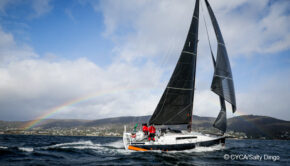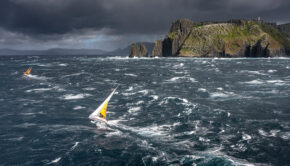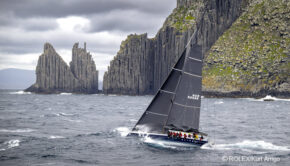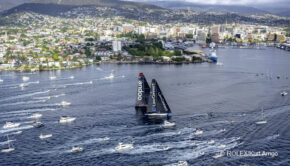Sydney Hobart: Won in a Day?
Published on December 31st, 2017
Could the 628-nautical-mile race be won in a day? Here is an analysis from ABC.net.au.
When Perpetual Loyal smashed the Sydney to Hobart line honours record by more than four hours in 2016, it was felt the new mark would stand for years, if not decades. But the very next race, in 2017, Comanche gouged a similar chunk out of the record. So, in the space of a year the winning time has been lowered by a whopping nine hours. But as in previous races, the supermaxis had a painfully slow trip up the River Derwent to the finish line. Which begs the question: how fast could these boats go given the perfect set of winds? Could they slice another nine hours off the record to reach Hobart within a day?
Why was this year’s race so fast?
This year’s record-breaking dash was five days faster than the inaugural time set by Rani in 1945. And yes, money and technology can take a lot of the credit for that but, as Cruising Yacht Club of Australia commodore John Markos points out, a bigger and better boat does not guarantee smooth sailing. “The only thing they can’t control is the wind, that’s the only lucky star in the whole thing,” he said.
Bureau of Meteorology forecaster Simon McCulloch said the start of the race was slow due to light winds in Sydney Harbour. “But once they got round the corner and out into the Tasman they had north-easterly winds that freshened right down the New South Wales coast, through Bass Strait and then were quite fresh [about 30 knots] down the Tasmanian coast as well,'” he said. “So all the way around to Tasman Island [there were] quite strong north-easterly winds, a very favorable direction.”
Could the 2017 race have been faster?
Yes, if Comanche and Wild Oats XI had made it to Storm Bay earlier they might have been able to sail into Hobart on a sea breeze. “They kind of hit a little bit of a brick wall where the winds were much, much lighter and so they really struggled up the Derwent on Wednesday evening,” Mr McCulloch said.
“The north-easterly prevailing wind … was just a little bit too strong to allow a sea breeze in.” He said it was rare to catch a strong north-easterly down the east coast followed by a favourable breeze up the Derwent.
Ichi Ban navigator Will Oxley said the best place for the fleet to make up time was on the long run down the coast. “If you could sail with the wind coming from the left-hand side of the boat, slightly aft, so that meant that you had your fastest sail combination up for the majority of the race, that is when we would see the record lowered,” he said.
How would the perfect race play out?
Mr Oxley’s dream race would begin with a good south-easterly out of Sydney Harbour followed by a “magical” wind shift to the north-east outside the Heads. “So you can point straight at Tasmania with your reaching sails and go very fast, as opposed to what we had this year which was down-wind conditions so the boats had to jibe, you had to zig-zag,” he said.
“Then when you get to Tasman Island the wind would magically shift to the south, and you would again reach all the way across Storm Bay. As you got to the entrance to the Iron Pot, it would shift into the east or the west and you would again reach up. They are the ideal conditions.”
Could the current supermaxis make it to Hobart in less than a day?
That depends on who you ask. Mr Oxley thinks so. “The world speed record for boats like that is around the 600-mile mark [in a day], just over, and the race is 630 miles,” he said. “In perfect conditions, Comanche could go under 24 hours.”
Triple Lindy sailing master Bradshaw Kellett estimated 22.5 hours would be the fastest possible time, but he was skeptical. “It would have to be 100 per cent perfect [conditions], better than this year’s forecast,” he said.
Mr Markos believes 30 hours is in reach for the current fleet. “Last year I said that the record was not going to be broken for a great many years and here we are again the very next year and it’s broken by four hours,” he said. “I’m not prepared to say that it won’t be a fast race next year.”
What could beat the supermaxis?
Mr Markos said the 24-hour mark could be cracked by the sort of boats competing in round-the-world races like the Vendee Globe. “The likes of the Vendee Globe boats, the ones that have foiling on the side that are able to reduce the wetted surface of the boat,” he said.
Mr Oxley agreed, saying the introduction of foiling boats would have a huge impact on the race. “We’re not yet seeing them in a race like this, but theoretically, a foiling boat could shatter the record,” he said.
Source: ABC.net.au









 We’ll keep your information safe.
We’ll keep your information safe.